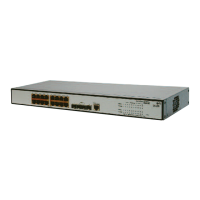1-20
After execution of this command, the system automatically transforms the public key file into PKCS
format, and imports the peer public key. This requires that you get a copy of the public key file from the
peer through FTP/TFTP.
z Only public key files in the format of SSH1 or SSH2 are supported.
z Currently, only public keys with the modulues being in the range 512 to 2048 bits can be imported
to the switch.
z You may use this command to configure an SSH peer’s public key on the current switch. After you
issue this command, the system will automatically identify the format of the public key, transforms
the public key into the PKCS format, and saves the public key locally. This public key configuration
method requires that the public key file be uploaded to the current switch through FTP or TFTP.
Examples
# Transform the format of client public key file abc and configure a public key named 123.
<Sysname> system-view
System View: return to User View with Ctrl+Z.
[Sysname] rsa peer-public-key 123 import sshkey abc
ssh authentication-type default
Syntax
ssh authentication-type default { all | password | password-publickey | publickey | rsa }
undo ssh authentication-type default
View
System view
Parameters
all: Specifies either the password authentication or the publickey authentication for SSH users.
password: Specifies the authentication mode for SSH users as password authentication.
password-publickey: Specifies that both the password and the publickey must be authenticated for
SSH users.
publickey: Specifies the authentication mode for the SSH user as publickey authentication.
rsa: Specifies the authentication mode for the SSH user as publickey authentication. The authentication
modes specified by the rsa keyword and publickey keyword are implemented in the same way.
Description
Use the ssh authentication-type default command to specify a default authentication mode for SSH
users. After this command is configured, when an SSH user is added by using the ssh user command,
the default authentication mode is adopted for the user if no authentication mode is specified by using
the ssh user authentication-type command.

